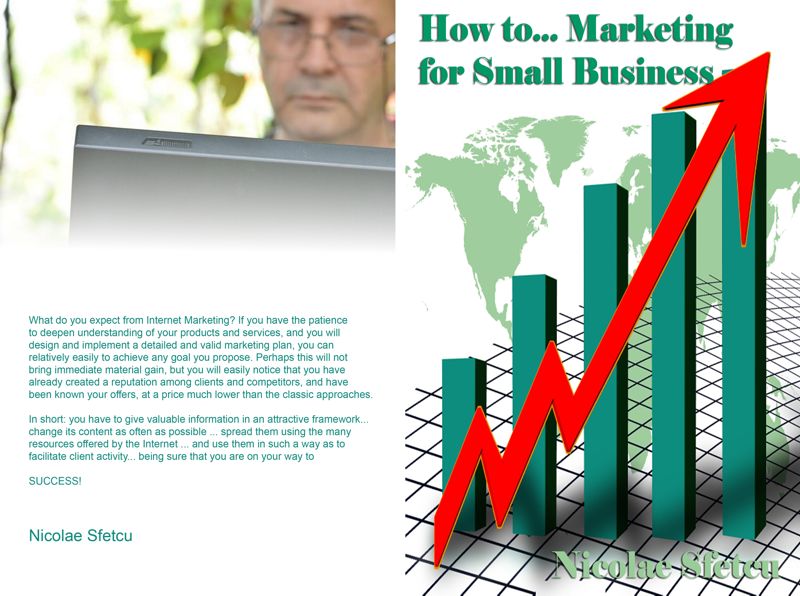The marketing approach is an attitude of research, analysis, listening to the market and its supposed environmental permit. Understanding consumer behavior involves a double research effort (via qualitative studies or quantitative studies). The intrinsic dimension is what is unique, which is unique to each person as a way to represent and practice the act of consumption. The extrinsic dimension consists of the external elements that surround and can influence their choices and decisions. For the marketer, the decision making process of the consumer spans stages and involves many parameters.
Market research are used to gather information to better understand the coveted target and environment (legal, political, social, regulatory, economic, cultural …) of the target. This will adapt methods of operational and strategic marketing accordingly.
Tag: Marketing
How to… Marketing for Small Business
 With the exponential growth of the popularity of the Web – the primary instrument using the Internet – an increasingly profitable activity began to be used by a growing number of companies: electronic advertising and marketing, instruments that offer tremendous opportunities at minimal cost .
With the exponential growth of the popularity of the Web – the primary instrument using the Internet – an increasingly profitable activity began to be used by a growing number of companies: electronic advertising and marketing, instruments that offer tremendous opportunities at minimal cost .
With more than billion of users worldwide and a big growth rate in the number of users per month, marketing on the Internet is much easier than the traditional methods. Taking into account that a typical marketing campaign causes a response rate of at least 2%, theoretically gives a huge number of answers on the Internet.
What do you expect from Internet Marketing? If you have the patience to deepen understanding of your products and services, and you will design and implement a detailed and valid marketing plan, you can relatively easily to achieve any goal you propose. Perhaps this will not bring immediate material gain, but you will easily notice that you have already created a reputation among clients and competitors, and have been known your offers, at a price much lower than the classic approaches.
In short: you have to give valuable information in an attractive framework… change its content as often as possible … spread them using the many resources offered by the Internet … and use them in such a way as to facilitate client activity… being sure that you are on your way to SUCCESS!
CONTENTS:
Introduction
Marketing or advertising?
– The key to success in online promotion
– Failures and solutions in web design
– – Solutions
– – Content
– – The goal of web marketing
– The e-marketing concept
– – So what is marketing?
– Elements of a successful presence on the Internet
– – Domain names
– – Design
– – Promotion
– – Visitors interest
Market research
– Business Plan
– Audience
– – Visitors
– Size and structure of the market
Consumption research
– Methods for the investigation of the needs
– Investigation of consumer behavior. Regaining lost customers.
Pricing Policy in Online Businesses
– Web design
– Attracting customers
– The shift from marketing to sales
– Merchant account
– Order form
– Online authorization
– Order tracking
– Technical challenges
– Subcontracting
– Conclusions
Short tips on online promotion strategy
Marketing policy
– When should you start?
– Marketing plan
– Guerrilla marketing
– – Link strategy
– – Banner strategy
– – e-Mail strategy
– – Web forums and mailing lists/e-groups
– – – Advertisements
– – – Online contacts
– – Online magazines / Newsletters
– – – 12 advices for a newsletter
– – Contests, prizes and freeware in marketing
– – – Organization of contests
– – – Awards
– – – Freeware
– Viral marketing
– – Where it comes from the power of the system?
– – How does viral marketing work?
– – Planning online business
– – Key Practices:
– – Key resources:
– – Planning elements:
Collecting and analyzing information
– Planning online business
– – Key Practices:
– – Key resources:
– – Planning elements:
Network marketing
Affiliate programs
– Choosing an affiliate program
– Setting up an affiliate program
– – Method #1
– – Method #2
– – Method #3
Online advertising
– Establish a clear goal
– Define the advert
– Site optimization
– Use the interactive capabilities of the Internet
– Copywriting
– – 1. Gathering information about the product
– – 2. Identify the essential characteristics of the product
– – 3. Identify the target audience
– – 4. Establish objectives of your message
– – 5. Identify the format of the message
– – 6. Develop the message
– Direct marketing techniques
– Increase the exposure
– Marketing brochures and flyers
– – Advice #1: Look – and only then try to see
– – Advice #2: Extreme simplicity
– – Advice #3: Bars and boxes
– – Advice #4: Do not forget the “nothing”
– – Advice #5: Less is more
– – Advice #6: Proportions
– – Advice #7: Adequacy
– – Advice #8: Color
– – Advice #9: Paper
– – Advice #10: Details
– Using the business card as a marketing tool
– Increasing sales through catalogs
– Television versus Internet in advertising
– – Similarities:
– – Differences
The marketing myths
– Myth #1: You can advertise for tens of millions people on the Internet
– Myth #2: If you currently do not act on Internet, you will lose a big chance
– Myth #3: You cannot advertise on the Internet
– Myth #4: If you try to advertise on the Internet, you will be burned alive
– Myth #5: You can make lots of money quickly on the Internet
– Myth #6: No one makes any money on the Internet
– Myth #7: Nobody can find you on the Internet. (Alternative: You can not find anything on the Internet)
Finally,
MultiMedia Publishing House https://www.telework.ro/en/e-books/marketing-small-business/
